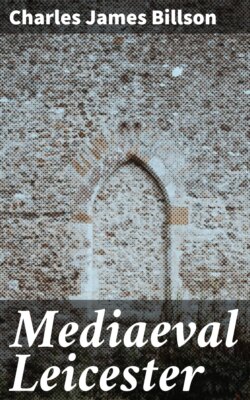Читать книгу Mediaeval Leicester - Charles James Billson - Страница 7
На сайте Литреса книга снята с продажи.
I.
THE STREETS.
ОглавлениеTable of Contents
THE little mediæval town of Leicester comprised about 130 acres. It was guarded on three sides by walls, which occupied, at least approximately, the site of the ancient Roman walls, or earthen ramparts. On the West lay the river Soar, and on that side no trace of any town wall has yet been found, although there was a gateway and a gate house, like the others, which stood in front of the West Bridge. The four gates of the town, over which, as early as 1322, hung the arms of the Sovereign, stood nearly at the North-West, North-East, South-East, and South-West points of the compass. The main road entered the town at the South Gate, and passed out at the North Gate, and the only other streets of importance were those which intersected the main road at the High Cross and ran to the East and West Gates. Other ways were mere lanes. The Borough Records sometimes describe the four chief streets leading to the four Gates as the four high streets, "quatuor altas stratas Leycestriae," but the High Street, par excellence, was that part of the King's highway which ran from the South Gate to the North. Of the two intersecting streets, that which led to the West Gate was called in part Hot-Gate, and in part Apple-Gate, and that which led to the East was known from an early date as the Swinesmarket. There were two suburbs beyond the walls, the North Suburb and the East. Outside the West Gate the Priory of the Austin Friars lay between the two arms of the river, and beyond it stretched the West Fields. The common lands of the town, known as the South Fields, or South Crofts, lay without the South Gate.
In the 13th century Leicester was divided into four Townships ships for police purposes, and these "vills" were known as the North, South, East and West Gates, The same division was also adopted in the collection of taxes, but as the population of one quarter would dwindle and that of another increase, changes were made from time to time in their names and boundaries. In a Pontage Roll of 1252, the division is E., N. & S. Gates, a blank (presumably W. Gate), and another blank (presumably East Suburb). In the Tallage Rolls from 1269 to 1280, the division into E., S., N. and W. quarters is regular, except that the West quarter is sometimes omitted, and the Suburb is sometimes added. It is stated once that the collectors were elected by the community from each quarter. After 1280 the practice became irregular, and in the first half of the 14th century there are many rolls with no divisions indicated. From 1342 to 1356 the division into a S. and N. quarter, an E. suburb, a Swinesmarket quarter, and a Saturday Market quarter is fairly regular. No W. quarter is mentioned, and the Bishop's tenants living in the Bishop's Fee are sometimes given separately. The Auditors of Account (1477-1492) were chosen from the E., S. and N. quarters and from the Swinesmarket. After 1492 they were chosen from "the E. quarter without the Gate," "the E. quarter within the Gate," and the S. and N. quarters. The original quarters were marked out by the four streets leading to the four gates.
